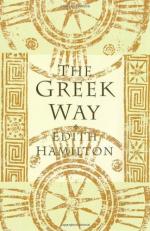|
This section contains 480 words (approx. 2 pages at 400 words per page) |

|
The Greek Way Summary & Study Guide Description
The Greek Way Summary & Study Guide includes comprehensive information and analysis to help you understand the book. This study guide contains the following sections:
This detailed literature summary also contains Topics for Discussion and a Free Quiz on The Greek Way by Edith Hamilton.
Twelve chapters of the book were published in 1930 under the Title "The Greek Way." In 1942, five new chapters were published with the original twelve under the title "The Great Age of Greek Literature." Current editions have retained the original title for the complete book and included the preface to the 1942 edition.
"The Greek Way" is an attempt to present to the modern reader an understanding and appreciation of the unique and distinctive cultural, intellectual and artistic achievements of Classical Athens. In particular, Hamilton focuses on fifth-century Athens, a time of significant political, social and intellectual change.
The unique and unparalleled achievements of fifth-century Athens are defined and delineated against both the intellectual, cultural and religious life of surrounding nations and the changing struggles and needs of Athenian culture itself. Comparison with other nations and cultures of the period emphasizes the distinction Hamilton draws between the life of the mind and the life of the spirit, between the rational and the irrational responses of human culture to pain, sorrow and fear. Comparison of Athenian writers of the period allows her to sketch changing responses to changing circumstances in Athenian society during this period.
Hamilton's intention in writing the book is clearly stated in the Preface to the 1942 edition as providing "a picture of Greek thought and art at the time of their highest achievement." Her goal is to provide to the modern reader a "perception of the breadth and depth and splendor of the intellectual life in fifth-century Athens."
Although the intention behind the book might have been originally more purely academic, as she wrote the Preface to the 1942 edition Hamilton was acutely aware of the abiding value of the Athenian intellectual achievement for later generations as they struggled to cope with difficult, confusing and frightening times. Indeed, much of the world was overwhelmed with confusion, fear and suffering in 1942.
There is, perhaps, no clearer statement of the abiding value of an understanding of the culture and art of fifth-century Athens for later generations than that contained in Hamilton's Preface. "We have many silent sanctuaries in which we can find a breathing space to free ourselves from the personal, to rise above our harassed and perplexed minds and catch sight of values that are stable, which no selfish and timorous preoccupations can make waver, because they are the hard-won and permanent possession of humanity."
The singular achievement of fifth-century Athenian culture was a unique intellectual balance in thought and life. These Athenians, she says, were uniquely able - throughout all of human history - to achieve the balance of mind and spirit, of intellect and religion that is the hallmark of human sanity. These Athenians were able to ascend to the intellectual heights that understood the importance of both the individual and the community and place both in proper perspective within the larger scheme of human existence.
Read more from the Study Guide
|
This section contains 480 words (approx. 2 pages at 400 words per page) |

|



